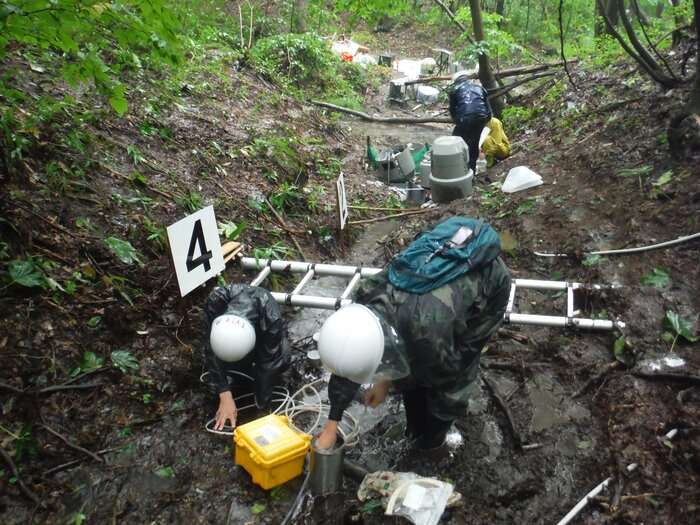Accelerated radiocesium leaching from forest floor litter by heavy rainfall

Radioactive materials including 137Cs (cesium-137, half-life: 30.1 years) were released into the environment following the accident at Fukushima Daiichi Nuclear Power Plant. It has been about 10 years since the accident, but 137Cs remains in the environment, especially in forests. Many researchers have been studying the dynamics and transport processes of radioactive materials in the environment. It has been found that radioactive materials are carried along with the transfer of water and sediment. With the focus on the forested headwaters where radioactive materials remain in large quantities, it has been reported that the concentration of dissolved radiocesium in stream water increases during heavy rainfall.
Since rainwater does not contain radioactive cesium, the research group led by Assistant Professor Koichi Sakakibara of Shinshu University's Faculty of Science was curious why the concentration of radioactive cesium in stream water increased during heavy rainfall without becoming diluted. The research team thought that radioactive cesium might have leached out from the forest litter and conducted leaching tests. They found that a large amount of radioactive cesium leached from such forest litter.
The next step was to ask the question, "Why does more radioactive cesium leach out of forest litter during heavy rainfall, when forest litter is still on the forest floor when it is not raining? (Background information: Most of the rainwater that falls on forests infiltrates into the subsurface area. The main reason for the increase in stream water volume during rainfall in forests is the discharge of groundwater. The groundwater contains almost no radioactive cesium.) So the research group set out to solve the mystery, "How is litter-derived radiocesium added to stream water during rainstorm?"
In contrast to the rainfall-runoff process, which is often focused only on rainfall and runoff, this study focused on the conversion process from rainfall to runoff, such as the variation of groundwater table level, the generation of saturated surface area at the bottom of the valley, and the variation of water quality and water age during rainfall. As a result, the answer to the problem to be solved in this study is that the main factor is the expansion of the contact area between water and litter due to the expansion of the saturated surface area caused by the rise of the groundwater table level in the forested headwater. Although previous research tended to focus only on the cause (rainfall) and the effect (runoff), Assistant Professor Sakakibara states, "we showed that the breakthrough to solve the unexplained reason lies in why the cause (rainfall) is converted into the effect (runoff)."
Uncertainty of results is inevitable when researching in the natural environment. How do results differ when the study is conducted at different times and places? How much error is there in the results due to the heterogeneity of the acquired samples from the environment? These are some of the questions that need to be answered. In the present study, the following questions were asked in-depth: 1) whether the same conclusions can be drawn for forests other than the target forest, 2) whether the samples collected for the study are representative of the Fukushima region, and 3) whether the results are affected by differences in the timing of litter falling from the trees and the degree of decomposition. Sakakibara says, "the most difficult part was to come up with a clear answer or idea to these uncertainties."
Assistant Professor Sakakibara says, "the state and transport of radioactive materials in the environment are complex and need to be studied long-term. The half-life of 137Cs is 30 years. The results of this study only partly clarified this issue. Rivers that discharge from the forest area flow downstream to the ocean. We would like to clarify the whole picture of the pathway and process of radioactive materials originating from forests in the hydrological process from the headwater to the ocean. We believe that these findings are essential for creating a safe and secure environment and sustainable future and livelihood."
The research was published in Science of The Total Environment.
More information: Koichi Sakakibara et al, Radiocesium leaching from litter during rainstorms in the Fukushima broadleaf forest, Science of The Total Environment (2021). DOI: 10.1016/j.scitotenv.2021.148929
Journal information: Science of the Total Environment
Provided by Shinshu University





















